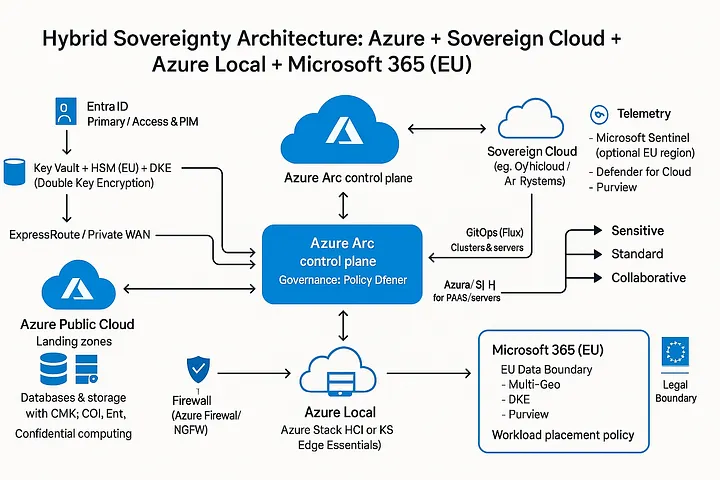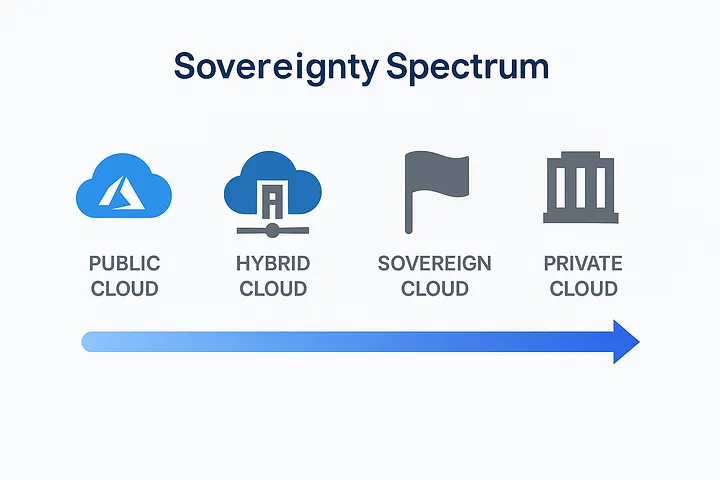Digital Sovereignty and the Public Cloud: Navigating Azure in a European Context
Introduction: Why digital sovereignty matters
Over the past decade, cloud adoption has shifted from an optional innovation to the standard approach for many. In Europe, Microsoft Azure, Amazon Web Services, and Google Cloud are the foundation of digital infrastructure. However, a key question has arisen: who really controls your data and workloads?
This is the heart of digital sovereignty, the ability of a state, organization, or individual to shape their digital future. It’s not just about where data is stored, but also about who can access it, under what laws, and with what safeguards in place. For cloud engineers and DevOps professionals, sovereignty may have seemed abstract until it began to affect core architecture decisions, such as encryption, multi-cloud strategy, and operational governance.
Join us as we dive into:
- What digital sovereignty looks like in Europe.
- The regulatory and political challenges shaping it.
- Clearing up common misconceptions.
- Your Azure options.
- Why hybrid cloud often makes the most sense.
- The trade-offs that come with it.
- What engineers need to prepare for.
The European landscape: regulation, politics, and sovereign tensions
Europe’s cloud infrastructure and policy landscape are heavily influenced by a complex interplay of regulatory frameworks, data privacy laws, and strategic priorities focused on digital sovereignty. The General Data Protection Regulation (GDPR) sets a strong compliance baseline, requiring organizations to enforce strict controls over data location, transfer methods, and access permissions to protect privacy and security. However, some legal uncertainties remain, especially after the Schrems II ruling, which invalidated the EU-US Privacy Shield and created new hurdles for cross-border data transfers. Moreover, the U.S. CLOUD Act allows U.S. authorities to access data stored abroad, including European data held by U.S. cloud providers, adding complications for European companies seeking to use cloud services worldwide.
To address these challenges, recent EU directives such as NIS2 and DORA have been put in place to greatly improve cybersecurity resilience across critical infrastructure sectors and strengthen vendor management controls. These directives are part of a broader strategic effort to protect digital assets and ensure operational continuity. At the same time, initiatives like GAIA-X and domestic cloud providers such as OVHcloud, Scaleway, and Deutsche Telekom are being developed to promote digital sovereignty, lowering reliance on foreign cloud services, and fostering a secure and innovative digital economy within Europe.
However, despite these regional advancements, these solutions often face significant obstacles in scaling, maturing, and achieving the operational robustness needed to match the capabilities of established hyperscalers like Amazon Web Services, Microsoft Azure, and Google Cloud. These global cloud giants have extensive infrastructure, advanced technological ecosystems, and a broad service portfolio that enable them to serve diverse enterprise needs worldwide.
The difference in size and development affects the regional solutions’ competitive position and their ability to integrate smoothly into the large, connected global cloud ecosystem. Overcoming these issues is essential for securing European digital sovereignty, staying competitive, and encouraging innovation in cloud technology. The hyperscaler dilemma: Azure’s benefits and sovereignty challenges
Microsoft Azure is widely regarded as one of the most trusted cloud platforms in Europe, primarily due to its robust data security and compliance features. Its EU Data Boundary initiative guarantees that customer data stored and processed across Azure, Microsoft 365, Dynamics 365, and Power Platform remains within the EU/EFTA regions, complying with regional data sovereignty laws. However, as a U.S.-based company, Azure remains subject to the CLOUD Act, meaning that U.S. authorities could potentially access data stored in EU data centers under lawful orders. Many organizations depend heavily on Azure’s Platform-as-a-Service (PaaS) offerings, which can lead to vendor lock-in, making it difficult to switch providers. This reliance results in operational inertia, as teams, governance frameworks, automation processes, and tooling are often heavily centered around Azure, creating significant challenges when attempting to adopt alternative cloud solutions or migrate workloads.
Clearing up misconceptions about digital sovereignty
When discussing digital sovereignty, the conversation often becomes entangled in a mix of legal terms, political statements, and technical jargon. The real meat of the issue, though, lies somewhere in between: the practical reality of how tech choices impact strategy, compliance, and growth. This is where misconceptions take hold. Some think sovereignty is merely a legal issue, while others view it as a technical formality, and still others assume it means giving up innovation altogether. To make progress, we need to sort fact from fiction and recognize sovereignty as a blend of tech integration, innovation, and long-term strategic planning.
Myth 1: “If my data is stored in an EU data center, I am considered sovereign over it.”
Reality: Although the physical location of data centers is important, true data sovereignty also relies on the legal jurisdiction. For instance, the CLOUD Act can still apply, impacting data stored in EU data centers. Recognizing both physical and legal factors is essential for maintaining data sovereignty.
Myth 2: “Going sovereign means abandoning the cloud.”
Reality: It is a common misconception that pursuing sovereignty requires leaving cloud environments. In fact, organizations can remain within cloud platforms like Azure while ensuring data sovereignty through advanced technical strategies such as implementing customer-managed encryption keys, utilizing confidential computing for secure data processing, and leveraging the EU Data Boundary to comply with regional data regulations. These options enable a balanced approach that combines the benefits of cloud scalability and innovation with strict adherence to sovereignty and compliance requirements, supporting both business agility and strong security.
Myth 3: “European providers match Azure feature-for-feature.”
Reality: While sovereign clouds ensure regulatory compliance and meet regional data sovereignty needs, they currently lack the same level of advanced artificial intelligence features, extensive global platform-as-a-service (PaaS) options, or the vibrant developer community that Azure offers. This often affects their suitability for businesses looking for cutting-edge technology and broad international scalability.
Myth 4: “Hybrid is too complex to be sovereign.”
Reality: With the emergence of advanced tools like Azure Arc, Kubernetes, and standards from the Cloud Native Computing Foundation (CNCF), managing hybrid and multi-cloud environments has become easier and more manageable. These technologies offer unified control, automate complex processes, and lower technical barriers, thereby simplifying operations and enabling organizations to maintain sovereignty and control over their hybrid infrastructures.
Myth 5: “Digital sovereignty is solely a legal issue.”
This reality also significantly influences key business and technical decisions. These decisions encompass critical areas, including system architecture, encryption method choices, workload placement strategies, and ensuring portability across various platforms. Addressing these aspects is crucial for maintaining control, enhancing security, and enabling flexibility in digital operations.
Strategic Paths for Azure-Centric Enterprises
If you’re deeply invested in Azure today, here are your pragmatic paths forward:
Stay with Azure — Sovereign by Design
- Business Perspective: Leverage Azure’s strategic European data centers to ensure compliance with regional data sovereignty laws, enhancing customer trust and enabling smoother regulatory approvals.
- Technical Perspective: Utilize EU/EFTA regions and Azure’s EU Data Boundary to store data within specified jurisdictions, applying customer-managed encryption, confidential compute, and double-key models to ensure data security and privacy.
- Additional Control Measures: Rely on contractual commitments such as EU Standard Contractual Clauses to formalize data protection obligations, strengthening control over data handling and compliance.
Hybrid Sovereignty
- Business Perspective: Balance innovation and compliance by running sensitive data and critical workloads in sovereign environments while deploying less sensitive, innovative workloads on Azure, optimizing costs and agility.
- Technical Perspective: Manage workloads through Azure Arc, enabling centralized governance across multiple environments, ensuring consistent security policies and compliance.
- Example Scenario: A banking institution processes sensitive payment data within a sovereign cloud, ensuring data sovereignty, while deploying mobile and web applications in Azure for scalability and rapid development.

Multi-Cloud / Exit Strategy
- Business Perspective: Reduce dependency on a single cloud provider by deploying applications across Azure and other EU cloud providers, enhancing resilience, negotiating power, and avoiding vendor lock-in.
- Technical Perspective: Maintain portability and flexibility using containerization, Kubernetes, and Infrastructure as Code (IaC) practices to facilitate seamless migration and interoperability.
- Trade-offs: Accept increased complexity and potentially higher costs in exchange for greater independence and resilience.
Why Hybrid Cloud often makes the most sense
Hybrid architecture might appear like a compromise at first, but in the area of data sovereignty and enterprise technology, it usually stands as the most balanced and strategic choice.
Advantages include:
- Greater control over sensitive and critical data, ensuring compliance with local regulations and security policies.
- Fostering innovation by leveraging cloud services like Azure, which offers advanced tools and scalable infrastructure.
- Avoiding the pitfalls of choosing only hyperscalers or solely sovereign solutions, thus maintaining flexibility.
However, there are challenges to consider:
- Managing operational complexity, especially in identity management, networking configurations, and policy alignment across different environments.
- Increased costs associated with maintaining and operating dual or hybrid environments.
- Necessity for robust governance frameworks to ensure security, compliance, and consistent policies across all platforms.
Real-World Examples:
- Government: Deploy a secure citizen registry system on sovereign infrastructure, using Azure Sovereign cloud services to ensure jurisdictional compliance and improved security. This includes encrypted data storage, identity management, and access controls through Azure Active Directory.
- Healthcare: Deploying protected patient data management systems on local cloud environments, in compliance with healthcare regulations like HIPAA, and additionally, integrating AI-driven diagnostic tools using Azure Machine Learning to support clinicians with quick and accurate disease detection.
- Manufacturing: Deploying edge computing devices for real-time IoT data collection and processing on-site, combined with advanced analytics and data visualization on Azure Synapse Analytics for predictive maintenance, operational efficiency, and supply chain optimization.
Business & Political trade-offs
Digital sovereignty comes with undeniable trade-offs:
Most enterprises will land somewhere in between — balancing speed and innovation with regulatory needs and political reality.
What Engineers need to prepare for
If you’re designing the future of your technology infrastructure, consider adopting comprehensive security and deployment strategies that align with modern business demands:
- Implement end-to-end encryption protocols, including customer key management and confidential computing, to ensure data security and build customer trust.
- Prioritize workload placement based on strategic considerations, making sure not all functions are confined to a single cloud provider like Azure. This approach allows for flexibility, cost savings, and risk reduction.
- Invest in gaining expertise in Azure Arc, hybrid cloud governance, and multi-cloud orchestration tools to manage diverse environments efficiently and securely.
- Design your infrastructure for portability using Infrastructure as Code (IaC), containerization, and open standards such as those from the Cloud Native Computing Foundation (CNCF). This prevents vendor lock-in and promotes agility.
- Understand and translate sovereignty requirements (regulatory or political) into specific architectural decisions, ensuring compliance while maintaining operational resilience.
By applying these principles, your architecture can support scalable, secure, and compliant business operations that adapt to the changing cloud landscape.
Conclusion: Pragmatism over purism
Today, digital sovereignty has become a crucial strategic focus in adopting and deploying cloud computing services, shifting from a niche concern to a core requirement for organizations operating in highly regulated or geopolitically sensitive areas. These organizations need to develop a nuanced approach that balances key factors such as:
- Innovation: utilizing cloud platforms like Azure, which offers a comprehensive suite of cloud services including compute, storage, AI, and IoT integrations, all supported by a vast global network footprint. This enables quick development and scaling of applications while allowing the localization of services as needed.
- Control: ensuring compliance with legal, data residency, and privacy regulations such as GDPR, HIPAA, or regional data sovereignty laws by implementing detailed access controls, data encryption, and audit logging within both the cloud environment and sovereign-specific infrastructure.
- Cost Optimization: managing budgets while considering the deployment of specialized sovereign infrastructure, such as private clouds or on-premises solutions, which may involve hardware procurement, maintenance, and integration with existing legacy systems.
- Delivery Speed: balancing the agility provided by cloud services with the complexity of regulatory requirements, which calls for automated provisioning, configuration management, and continuous integration/continuous deployment (CI/CD) pipelines that include compliance checks.
- Political and Regulatory Alignment: supporting initiatives like the Digital Single Market or European Cloud initiatives to ensure compliance with regional policies without compromising the enterprise’s global competitiveness.
Rather than choosing solely between hyperscalers or sovereign solutions, a hybrid cloud architecture often provides the best approach by combining the scalability, extensive ecosystem, and advanced services of providers like Azure with dedicated sovereign infrastructure for sensitive workloads.
As cloud engineers, architects, and DevOps professionals, our roles are evolving. We are now responsible for translating strategic, legal, and political directives into scalable, automated infrastructure and deployment pipelines. Designing with sovereignty in mind isn’t about rejecting cloud computing but about enhancing and customizing it to meet specific national or organizational sovereignty requirements, ensuring compliance without sacrificing innovation or agility.
Relevant Links & Resources:
- Europe’s push for digital sovereignty and challenges (TechRadar/FT)
- CLOUD Act implications and EU conflict (GDPR vs CLOUD Act) — clarity on legal tension.
- Microsoft EU Data Boundary overview — ensures data resides and processes within EU/EFTA regions.
- AWS European Sovereign Cloud
- Microsoft Sovereign Cloud
Want to know more about what we do?
We are your dedicated partner. Reach out to us.




